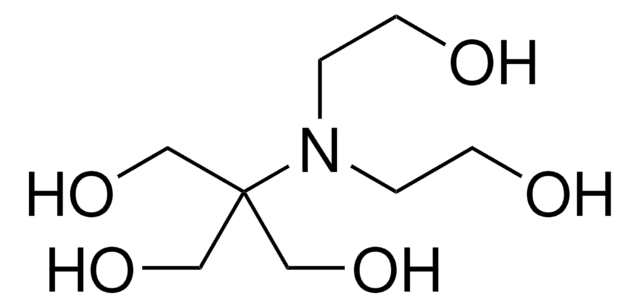34871
1-Propanol
suitable for HPLC, ≥99.9%
Synonyme(s) :
Alcool propylique
About This Item
Produits recommandés
Densité de vapeur
2.1 (vs air)
Niveau de qualité
Pression de vapeur
10 mmHg ( 147 °C)
14.9 mmHg ( 20 °C)
Pureté
≥99.9%
Forme
liquid
Température d'inflammation spontanée
700 °F
Limite d'explosivité
13.7 %
Technique(s)
HPLC: suitable
Impuretés
≤0.0005% non-volatile matter
≤0.001% free acid (as C2H5COOH)
≤0.05% water (Karl Fischer)
Résidus d'évap.
≤0.005%
Transmittance
220 nm, ≥40%
240 nm, ≥85%
275 nm, ≥99%
Indice de réfraction
n20/D 1.384 (lit.)
pH
8.5 (20 °C, 200 g/L)
Point d'ébullition
97 °C (lit.)
Pf
−127 °C (lit.)
Densité
0.804 g/mL at 25 °C (lit.)
λ
neat
Absorption UV
λ: 220 nm Amax: ≤0.40
λ: 240 nm Amax: ≤0.071
λ: 275 nm Amax: ≤0.0044
Chaîne SMILES
CCCO
InChI
1S/C3H8O/c1-2-3-4/h4H,2-3H2,1H3
Clé InChI
BDERNNFJNOPAEC-UHFFFAOYSA-N
Vous recherchez des produits similaires ? Visite Guide de comparaison des produits
Catégories apparentées
Description générale
Application
Mention d'avertissement
Danger
Mentions de danger
Conseils de prudence
Classification des risques
Eye Dam. 1 - Flam. Liq. 2 - STOT SE 3
Organes cibles
Central nervous system
Code de la classe de stockage
3 - Flammable liquids
Classe de danger pour l'eau (WGK)
WGK 1
Point d'éclair (°F)
71.6 °F - closed cup
Point d'éclair (°C)
22 °C - closed cup
Certificats d'analyse (COA)
Recherchez un Certificats d'analyse (COA) en saisissant le numéro de lot du produit. Les numéros de lot figurent sur l'étiquette du produit après les mots "Lot" ou "Batch".
Déjà en possession de ce produit ?
Retrouvez la documentation relative aux produits que vous avez récemment achetés dans la Bibliothèque de documents.
Notre équipe de scientifiques dispose d'une expérience dans tous les secteurs de la recherche, notamment en sciences de la vie, science des matériaux, synthèse chimique, chromatographie, analyse et dans de nombreux autres domaines..
Contacter notre Service technique








